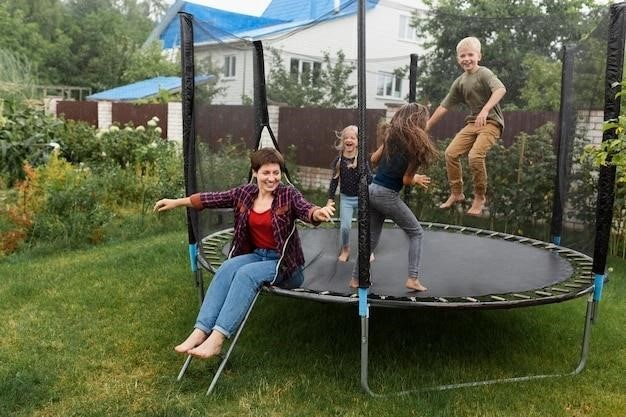
trampoline sizes guide
Choosing the Right Trampoline Size⁚ A Comprehensive Guide
Choosing the right trampoline size is crucial for both safety and enjoyment․ This guide will help you navigate the various sizes and shapes available, providing you with the knowledge you need to make an informed decision․ We’ll cover factors to consider, popular trampoline sizes, and safety considerations․ Let’s dive in and find the perfect trampoline for your backyard!
Introduction
Trampolines have become a staple in backyards across the globe, offering a fun and exhilarating way to exercise and entertain․ But with so many different sizes and shapes available, choosing the right trampoline can feel overwhelming․ The size of your trampoline will directly impact its safety, functionality, and the overall enjoyment you and your family will derive from it․
This comprehensive guide will equip you with the knowledge necessary to make an informed decision about the perfect trampoline size for your needs․ We’ll explore the various factors to consider, break down popular trampoline sizes, and discuss safety considerations to keep in mind․ By the end of this guide, you’ll be confident in selecting a trampoline that meets your backyard’s space, your family’s needs, and your safety expectations․
Understanding Trampoline Sizes
Trampolines come in a wide range of sizes, measured in feet, typically ranging from 8 feet to 15 feet in diameter for round trampolines․ The size you choose will significantly affect the trampoline’s stability, bounce, and the number of people who can safely use it․ You’ll also find rectangular trampolines, which offer a different jumping experience and may be more suitable for certain backyard layouts․
Trampoline sizes are not standardized across manufacturers, so it’s crucial to consult the specific dimensions provided by the brand you are considering․ Look for the diameter or length and width for rectangular trampolines, as well as the overall height, which includes the frame and enclosure (if applicable)․ Understanding these dimensions will help you determine if a particular trampoline will fit comfortably in your backyard and allow enough room for safe jumping․
Factors to Consider When Choosing a Trampoline Size
When choosing a trampoline size, several factors come into play․ It’s not just about the available space but also the intended use and the number of people who will be jumping․ A well-considered decision will ensure safety, enjoyment, and a long-lasting investment․ Here are the key considerations⁚
First, assess the available space in your backyard․ Measure the area where you plan to place the trampoline, taking into account the surrounding structures, trees, and any potential hazards․ Remember to factor in the necessary clearance around the trampoline for safe jumping, which typically includes at least 2 meters laterally and 8 meters overhead․
Space Available
The available space in your backyard is the primary factor in determining the right trampoline size․ A 10ft trampoline may be perfect for a smaller yard, while a larger 14ft or even 15ft trampoline might be needed for a spacious area․ It’s crucial to measure the available space carefully and leave sufficient clearance around the trampoline for safety․ This clearance is essential for preventing potential injuries due to collisions with surrounding structures or obstacles․
Consider the shape of your yard as well․ A rectangular trampoline might be a better fit for a long, narrow space, while a round trampoline might be more suitable for a square or circular area․ Ultimately, choosing the right size and shape will ensure that the trampoline fits seamlessly into your backyard, creating a fun and safe jumping zone․
Number of Jumpers
The number of people who will be using the trampoline is a crucial factor in choosing the right size․ Smaller trampolines, typically around 8ft to 10ft, are suitable for one or two jumpers at a time․ These smaller trampolines are ideal for younger children or families with limited space․ For larger families or gatherings, a larger trampoline is recommended․ A 12ft or 14ft trampoline can accommodate multiple jumpers, allowing for more fun and excitement․ It’s essential to ensure that the trampoline has a weight capacity that can safely handle the combined weight of all jumpers․
It’s also important to consider the age range of the jumpers․ A smaller trampoline might be sufficient for young children, while a larger trampoline is necessary for older children and adults who require more jumping space․ Choosing a trampoline that accommodates the number of jumpers and their age range will ensure a safe and enjoyable experience for everyone․
Age and Weight of Jumpers
The age and weight of the intended jumpers are critical considerations when choosing a trampoline․ Younger children typically require smaller trampolines with lower weight capacities, while older children and adults may need larger trampolines with higher weight limits․ A general guideline is to choose a trampoline with a weight capacity that exceeds the combined weight of all jumpers by at least 20%․ This ensures that the trampoline can handle the impact of jumping and prevent potential damage or accidents․
It’s important to note that trampoline weight limits are not just for safety but also for performance․ A trampoline that is overloaded can become less bouncy and responsive, affecting the jumping experience․ Choosing a trampoline that is appropriately sized for the age and weight of the jumpers will ensure a fun and safe experience for everyone․
Popular Trampoline Sizes and Their Suitability
Trampolines come in a variety of sizes, each with its own set of advantages and disadvantages․ Here’s a breakdown of the most popular trampoline sizes and their suitability for different needs⁚
• Small Trampolines (8ft ౼ 10ft)⁚ These compact trampolines are ideal for smaller backyards and families with young children․ They offer a safe and fun jumping experience for one or two children at a time․
• Medium Trampolines (12ft ౼ 14ft)⁚ These popular sizes are great for families with multiple children or those who enjoy bouncing with friends․ They offer ample jumping space and are suitable for most backyards․
• Large Trampolines (15ft and Above)⁚ These spacious trampolines are perfect for larger families or those who want to host trampoline parties․ They provide plenty of room for multiple jumpers of all ages․
When selecting a trampoline size, consider the space available in your backyard, the number of jumpers, and the age and weight of the intended users․

Small Trampolines (8ft ౼ 10ft)
Small trampolines, typically ranging from 8 to 10 feet in diameter, offer a compact and affordable option for families with limited space or young children․ Their smaller size makes them easy to maneuver and store, and they can fit comfortably in smaller backyards․ However, due to their limited jumping area, it’s recommended to have only one child on the trampoline at a time, ensuring safety and preventing overcrowding․ Small trampolines are perfect for introducing children to the joys of bouncing and can provide hours of entertainment without taking up too much space․
These trampolines are often described as “nice and compact” and have a similar application to round 8 or 10ft trampolines․ They’re suitable for popping in between a cubby house, swing set, or garden shed․ While they offer a fun jumping experience, it’s essential to enforce a one-child-at-a-time rule on these smaller models to ensure safety and prevent accidents․
Medium Trampolines (12ft ‒ 14ft)
Medium-sized trampolines, ranging from 12 to 14 feet in diameter, represent a popular choice for families seeking a balance between space and affordability․ These trampolines offer ample jumping room for multiple individuals, making them ideal for both children and adults․ They provide sufficient space for various activities, from simple bouncing to more complex games and exercises․ Their size also allows for a more dynamic and engaging jumping experience, making them a favorite choice for active families․
Medium-sized trampolines, specifically 12ft and 14ft models, are considered to be in the “sweet spot” of trampoline sizes․ They provide enough space for fun and bouncing without being too large for most backyards; These trampolines are suitable for families with older children who want room to bounce, play games, and relax, making them a versatile and enjoyable addition to any outdoor space․
Large Trampolines (15ft and Above)
Large trampolines, measuring 15 feet or more in diameter, are designed for those who prioritize ample jumping space and accommodate multiple users simultaneously․ These are ideal for families with larger yards and a desire for a truly expansive bouncing experience․ They offer ample room for games, acrobatic stunts, and even group activities, providing endless entertainment for everyone․ Large trampolines are also popular for gymnastic training and fitness enthusiasts, offering a challenging and rewarding workout environment․
While large trampolines provide the ultimate in jumping space, they require careful consideration regarding available yard space and safety․ Their size necessitates a significant amount of open area for safe use, and it’s essential to ensure adequate clearance around the trampoline for a safe jumping experience․ Despite the space requirements, large trampolines provide a fantastic opportunity for families and individuals seeking a spacious and exciting jumping environment․
Safety Considerations
While trampolines provide endless fun and exercise, safety should always be a top priority․ Choosing the right size is only one aspect of ensuring a safe jumping experience․ It’s crucial to follow these guidelines⁚
- Supervise Children⁚ Never leave children unsupervised on a trampoline․ A responsible adult should always be present to monitor activities and enforce safety rules․
- One Jumper at a Time⁚ For smaller trampolines (8ft-10ft), restrict use to one jumper at a time to prevent collisions and potential injuries․
- Enforce Weight Limits⁚ Adhere to the maximum weight limit specified by the manufacturer․ Overloading the trampoline can lead to structural damage and potential accidents․
- Proper Enclosure⁚ A safety enclosure is essential for all trampolines․ It helps prevent jumpers from falling off and provides a secure environment for jumping․
- Safe Landing Area⁚ Ensure that the area surrounding the trampoline is clear of obstacles and hazards․ A soft, padded surface can also help minimize the impact of falls․
- Appropriate Footwear⁚ Encourage jumpers to wear appropriate footwear, such as sneakers or athletic shoes, to provide stability and prevent injuries․
- Avoid Stunts and Tricks⁚ Discourage dangerous stunts and flips on the trampoline, as these can lead to serious injuries․
By implementing these safety measures, you can create a fun and safe jumping experience for all․ Remember, responsible use and constant supervision are key to preventing accidents and ensuring everyone enjoys the benefits of trampoline fun․
Choosing the right trampoline size is an important step in ensuring a fun and safe jumping experience for your family․ By considering factors like available space, the number of jumpers, and their age and weight, you can select a trampoline that perfectly suits your needs․ Remember that safety should always be a top priority․ Enforce strict rules, supervise children, and ensure proper maintenance to minimize the risk of accidents․ A trampoline is an excellent source of exercise and entertainment, but responsible use is crucial for maximizing enjoyment and minimizing potential risks․ With careful planning and a focus on safety, you can create a backyard haven for active play and healthy fun for years to come․